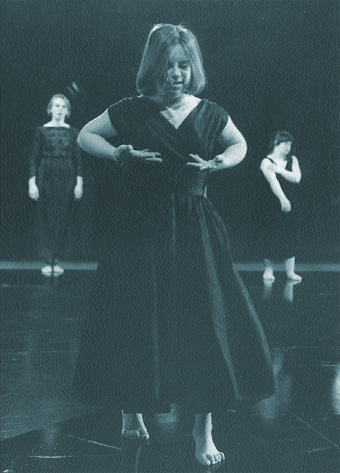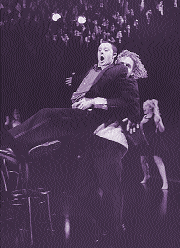Enabling dance
Anne Thompson talks to Sally Chance of Adelaide’s Restless Dance Company

Nadia Ferencz in Sex Juggling, Restless Dance Company
David Wilson
Nadia Ferencz in Sex Juggling, Restless Dance Company
In my interview with Meryl Tankard in RealTime #21 (“Free from Steps”) I hoped to tease out the meanings of terms she uses to talk about her work and dance in general—terms borrowed from a Modernist discourse. This proved difficult as the meaning of these terms was clearly implicit for Meryl and important to her. For this issue, I interviewed Sally Chance, artistic director of Restless Dance Company in Adelaide. Sally is clearly conscious of the necessity of speaking across existing discourses of aesthetics and identity. She also acknowledges the effect of doing so and thus how using a certain discourse can be a strategy for social change.
AT Why was Restless Dance formed? What is its charter? What drives you to run such a company?
SC The simple answer is that the time was right. My involvement began when I toured to Australia with Ludus Dance Company from the UK as one of their community dance workers at the 1989 Come Out Festival. Part of my role on tour was to run workshops. While we were in Adelaide I ran dance workshops with groups of differently-abled people including those with Down syndrome and cerebral palsy. This was a new area for dance in Australia. A couple of years later I decided to leave Ludus. I was interested in working in Australia but needed to establish myself as a specialist in an area of work to obtain permission to live and work here. So I thought I would seek work as a dance animateur with differently-abled people. Carclew Youth Arts Centre provided me with that opportunity. The company thus began as a youth arts project initiated by project officers Judy Potter and Virginia Hyme.
Since its inception in 1991 Restless Dance has held hundreds of workshops for fun and recreation, for skill and personal development, for industry professionals and for school and community groups. We’ve also performed in festivals, at conferences, at launches, at benefits, toured interstate and performed in Adelaide’s premier theatres.
The company’s aims are: to create and present excellent and challenging dance theatre nationally and internationally; to provide high quality dance workshops for people with and without a disability; to increase the profile of dance and disability in the community; to provide enjoyable recreational experiences.
AT What is your vision for the company?
SC When the company was associated with Carclew, project officers considered it important that workshops had a public outcome. So there has always been a split focus for me. I have always had community goals and artistic goals. The company is currently in transition. We have been incorporated for nearly a year. We would like triennial funding but the Australia Council’s Dance Fund doesn’t fund youth companies. We are also at a stage where some of the dancers, who have been with the company since its inception, deserve to be paid to co-direct and lead workshops as well as to perform. These dancers have become skilled and should be eligible for professional status. I’d like to establish a small professional company with a core group of performers as well as continue the work of the youth company. Each would contribute something different.
AT Could you talk about the company in relation to disability politics?
SC The policy of the company is “reverse integration” in which the expressive skills of the participants with disabilities define the company’s unique style. This policy developed in response to three perceptions: Firstly, integration was the policy of the disability support services when the company began. This policy was connected to two other notions—normalisation and social role valorisation. In practical terms this policy involved placing individuals with disabilities in tedious jobs at low pay.
These individuals were not encouraged to have aspirations beyond being employed. They were not encouraged to be ambitious within the workplace, or to desire other life experiences such as personal health and fitness, sexual relationships, home ownership, children or travel. I, alongside some workers in the disability sector, began to feel quite cynical about the so-called ‘opportunities’ being offered to the disabled. I became interested in helping to redefine identity for this group in a broader way. I felt people gained identity options through leisure activities as well as through paid work. I thought that being a dancer could be one of these options.
Secondly, I also questioned the definition of ‘normal’ being used as the yardstick in determining lifestyle for the disabled. In my experience ‘normal’ people don’t dance so I am not ‘normal’ in the way the word was being used. I also observed that in my dance classes the carers who accompanied the ‘dis-abled’ were often less skilled as dancers and as workshop participants than their so-called clients. What then was ‘normal’ behaviour in a situation such as a creative dance class?
Thirdly, I also felt that it was unfair that the person with the disability had to make all the effort in relation to integration. However, we have lost some workshop participants because of our policy. Some parents prefer their child to be a member of a group of predominantly able-bodied people or with able-bodied norms of behaviour.
AT Do you perceive dance training to be a tool of socialisation, a means by which unruly bodies can be disciplined?

Ziggy Kuster and Stephen Noonan in Sex Juggling
photo David Wilson
Ziggy Kuster and Stephen Noonan in Sex Juggling
SC Dance means as many different things to this population as it does across the general category of “people who dance”. For some it’s a means of getting fit, for others it’s a social activity and for others it serves an expressive purpose. Some company members like their jobs and dance for fun. Others are bored at work and the experience of being in the company has enabled them to become more ambitious. One company member wants to become a full-time dancer. In workshops, I explore a range of goals such as the development of social skills and physical skills, personal expression, self-discipline and I challenge behaviour patterns.
AT Could you talk about the company’s style?
SC I always focus on the group rather than on individuals and encourage participants to work as a group. I ask members to watch and copy each other. Thus, in performance everyone tends to do everything. Improvisation is the primary approach taken in workshops and a crucial aspect of the performances which can differ depending on how a participant is feeling. Because of this variable, I set up a “time-out” space for the performers during the show.
I select material on the basis of whether the dancers look comfortable doing it. I always work from a movement focus and then suggest links with emotion rather than the other way around. I find that these dancers have a powerful understanding of gesture as a dance language and of touch. Contact work, unison work and gesture have thus become the identifiable components of the company’s style.
AT Could you talk a little about Restless Dance’s last piece, Sex Juggling?
SC It explored a particular category of personal identity. The company divided into male and female groups to explore the idea of gender roles and behaviours and to devise and create dance. The project began with some sex education workshops run by the Family Planning Association. This aspect of identity seemed important to address as sexism, and the subsequent limiting of gender roles, can occur within the company.
My interest is in providing someone with a disability with as many terms with which to define themselves as are available to someone without a disability. Calling yourself a dancer is one of these options. Considering yourself male or female and sexual are others.
RealTime issue #22 Dec-Jan 1997 pg. 31






